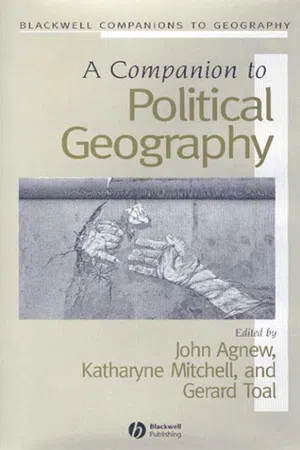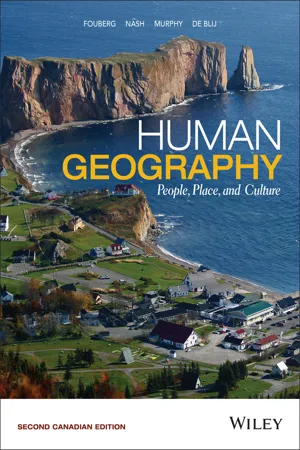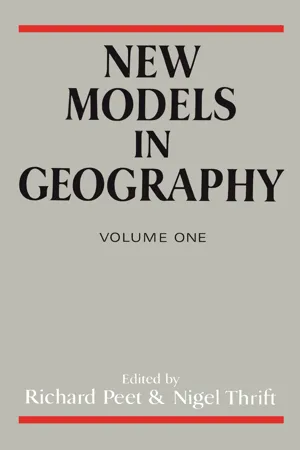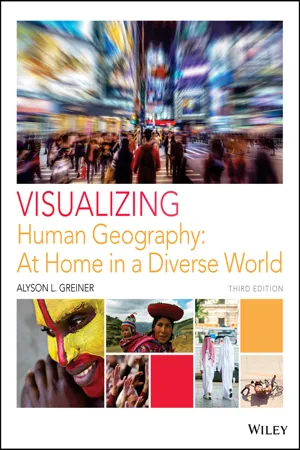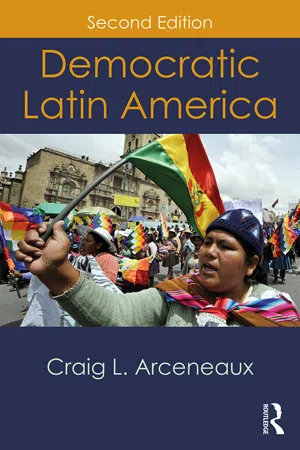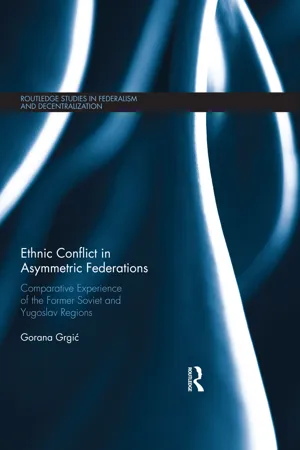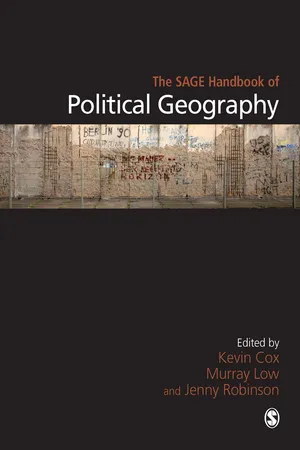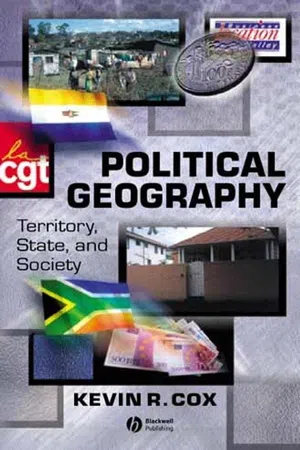Geography
Unitary State
A unitary state is a political system in which most of the power is held by the central government, with little autonomy given to regional or local governments. This centralized form of governance contrasts with federal systems, where power is shared between the central government and regional authorities. Unitary states are often characterized by uniform laws and policies across the entire country.
Written by Perlego with AI-assistance
Related key terms
1 of 5
9 Key excerpts on "Unitary State"
- eBook - PDF
- John A. Agnew, Katharyne Mitchell, Gerard Toal, John A. Agnew, Katharyne Mitchell, Gerard Toal(Authors)
- 2008(Publication Date)
- Wiley-Blackwell(Publisher)
Either way, the force of a unitary centralized power remains intact and its ``store'' of capabilities present and awaiting distribution. Although somewhat sparse as a diagram of power, it is nonetheless one that underpins the ``state-centred'' versions of power criticized by John Agnew (1994, 1999; see also Agnew and Corbridge, 1995) in his attempt to map political power beyond state boundaries. His target was the conventional understandings of the geography of political power held by mainstream international relations theorists and relatedly those of a political realist persuasion who considered the state to be a unitary and singular actor. At the nub of his concerns was the simple equation of state territoriality with a stable, bounded set of power relations that ``contains'' all that really matters politically. Distinguishing (following Walker, 1993) between an internal, domestic space in which governments exercise power in an orderly fashion through the distribution of their powers, and an external, international domain defined by the absence of order, the ``territorial state'' in mainstream international relations is represented as a uniform political community maintained and controlled from an identifiable center. As such, the spatial organization of rule-making author-ity is portrayed as an almost effortless process whereby power radiates out from the center to select elites and bureaucratic agencies. In this view, power is almost akin to a solid ``bloc,'' whose certainties are then spread from the center outwards, and neither distance nor dispersal problematizes its reach. Barry Barnes (1988), in particular, has questioned whether such traditional forms of delegation really do work in that manner. In the first place, he argues that an element of discretion is built into the very exercise of power: once authority is devolved, delegates are empowered and able to make independent use of their new-found capabilities. - eBook - PDF
Human Geography
People, Place, and Culture
- Erin H. Fouberg, Alexander B. Nash, Alexander B. Murphy, Harm J. de Blij(Authors)
- 2015(Publication Date)
- Wiley(Publisher)
Two common governmental structures are unitary and federal. To address multination states, governments, even demo- cratic governments, can and have suppressed dissent by force- ful means. Until the end of World War II, most European governments were unitary governments: they were highly centralized, with the capital city serving as the focus of power. States made no clear efforts to accommodate minorities or outlying regions where iden- tification with the state was weaker. Europe’s nation-states were Unitary States, with the culture of the capital city Unitary (state) A nation-state that has a centralized govern- ment and administration that exercises power equally over all parts of the state. Federal (state) A political- territorial system wherein a central government represents the various entities within a nation-state where they have common interests—defence, foreign affairs, and the like—yet allows these various entities to retain their own identities and to have their own laws, policies, and customs in certain spheres. defined as the nation’s culture. Any smaller nations within (such as Bretons in France or Basques in Spain) were repressed and suppressed. A unitary government’s administrative frame- work ensures the central government’s authority and control over all parts of the state. The French government divided the state into more than 90 départements, whose representatives came to Paris not to express regional concerns but to im- plement governmental deci- sions back home. Another way to govern a multinational state is to con- struct a federal system, orga- nizing state territory into regions, substates, provinces, or cantons. In a strong federal system, the regions have a lot of - eBook - ePub
New Models In Geography
Volume 1
- Richard Peet, Nigel Thrift(Authors)
- 2013(Publication Date)
- Routledge(Publisher)
The state, political geography, and geographyR. J. Johnston
A major component of the spatial organization of the Earth’s surface is its division into 150 or so sovereign states, each with a well defined (though perhaps contested) territorial reach. This division is commonly used in social sciences as a basic set of units of analysis – the world is described, and accounted for, in terms of similarities and differences among its states. That division is often accepted as unproblematic: it is natural to use countries as reporting units (despite some debate over whether countries are regions (Johnston 1984d)). The validity of this approach has rarely been questioned by political geographers, among whom the need for, and hence existence of, states has normally been taken for granted (Johnston 1980a, 1981a, 1981b). Further, the links between political geography and economic and social geography have rarely been explored, so that until recently the rôles of the state in everyday life, and the importance of state territory in that, have not been central geographical concerns.Attention has recently been directed towards the study of the state, however, and to incorporating political geography within the broader corpus of the discipline. In part this reflects the growth of the institution and apparatus of the state; it has been enlarged into a phenomenon that cannot be ignored in analyses of the contemporary scene (as many of the other chapters in this book indicate). There are studies not only of what the state does, but also of why: to understand state action, it is argued, we must understand why we have states.The issue of why we have states could be dismissed as of little relevance to the study of human geography. However, according to some arguments (e.g. Mann 1984, 1986) the state differs from other institutions because it is necessarily a territorial body - eBook - PDF
Visualizing Human Geography
At Home in a Diverse World
- Alyson L. Greiner(Author)
- 2017(Publication Date)
- Wiley(Publisher)
The use of such territorially defined political units has become the dominant mode of political organization around the world only within the past four centuries. Throughout most of human history, people organized themselves in different ways, for example, according to class, kinship, or as subjects owing allegiance to a king, an emperor, or other ruler. (Source: NG Maps.) key concepts in political geography: the development of the state. The practice of using territory as a basis for po- litical organization stems from ideas about sovereignty that gained prominence following the Peace of Westphalia in 1648. This peace settlement included a series of trea- ties signed at the end of the Thirty Years’ War, a long religious and territorial conflict in Europe. Since the mid-17th century, then, sovereignty has meant that states are distinct territorial units, that one state has no business inter- fering in the affairs of another state, and that states are expected to recognize the existence of other states. the space around our bodies that we consider to be an extension of ourselves and therefore “our space.” People differ a great deal in terms of how expansive their personal space is but are likely to feel uncomfortable when others encroach on it. The presence of political states (countries) that are connected with a specific territory shows that ter- ritoriality exists among groups of people (Figure 7.1). The Development of the State and Its Sovereignty How did the political map of the world come about? Although the answer to this question goes beyond the scope of this chapter, the question points to one of the sovereignty Supreme authority of a state over its own affairs and freedom from control by outside forces. Key Concepts in Political Geography 175 176 CHAPTER 7 Political Geographies fact of the matter is that people, acting on be- half of states, use it to suit their own purposes. Thus, questions of sovereignty can become a basis for political disputes. - eBook - ePub
- Craig L. Arceneaux(Author)
- 2017(Publication Date)
- Routledge(Publisher)
unitary regime, final authority in all policy areas rests in the national government. A unitary regime may allocate power to a regional government, but unlike in the federal regime, such authority can be legally retracted.The Division of Power in a Federal SystemFederalism entails a rather common division of labor in most countries. Foremost, only the national government holds international sovereignty and the unqualified right to enter into international agreements with other countries. Subnational units enjoy sovereignty, but only in respect to each other and the central government (Gibson, 2004, pp. 5–6). To support its role in the global arena, national governments usually retain primary competencies over matters of defense, and take charge of economic planning. Lower levels of government typically focus on social affairs such as health, education, welfare, and cultural programs, as well as the maintenance of law and order.Normally, the constitution will specify these exclusive competencies, but it may also recognize inevitable overlaps by detailing concurrent powers. Sometimes the constitution sets out concurrent powers such that the national government drafts general guidelines, and leaves it to the subnational governments to accommodate their own interests as they fill in the details. Article 24 of the Constitution of Brazil lists a number of concur-rent powers, such as the protection of historical and cultural monuments, court procedures, social security, and education, and then notes, “within the confines of concurrent legislation, the power of the federal government is limited to establishing general guidelines.”And to ensure an exhaustive allocation of powers, constitutions will normally refer to residual powers, or those powers not expressly mentioned. Most countries assign residual powers to the subnational governments. However, the development of implied powers - eBook - ePub
Ethnic Conflict in Asymmetric Federations
Comparative Experience of the Former Soviet and Yugoslav Regions
- Gorana Grgić(Author)
- 2016(Publication Date)
- Routledge(Publisher)
Part IIPassage contains an image
1Dynamics of ethnonationalist mobilization and occurrence of conflicts in asymmetric federations
“[G]roups become mobilized into politics without becoming socialized by politics.” (Samuel Huntington 1968, p. 83)Based on the taxonomy of polities with respect to the system of government, all states can be placed on a continuum ranging from unitary to confederal arrangements, with federal states the middle. Unitary States are structured in such a way that all decision-making rests in the hands of the central government and the decision-making flows from the centre to the local provinces or entities. A totalitarian state would represent the most extreme version of a Unitary State since all political power is said to be concentrated in the centre and at the top of a hierarchical power structure, resulting in ‘total control’ by ruling elites or a single leader. Federal systems sit in between unitary and confederal arrangements and they are characterized by power-sharing arrangements between a strong central government and strong governments of first-order administrative units. In theory, federalism provides uniformity, which is the strength of the unitary system when necessary, while at the same time allowing for diversity and local rule when needed. At the opposite end of the spectrum are confederal arrangements where the first-order administrative units hold political power and the central government has authority only over a narrow range of policy issues (Kaiser 1994).There has been an extensive debate over whether federal arrangements are conflict-mitigating solutions (Nordlinger 1972; Lijphart 1977; Kymlicka 1995; Brubaker 1996; Cohen 1997; Stepan 1999; Gurr 2000; Bermeo 2002) or whether they highlight the inherent instability of a given political system (Riker 1964; Lemco 1991; Crawford 1998; Skalnik Leff 1999; Stepan 1999; Roeder 2009). The effectiveness of ethnofederal solutions are part of this debate – on the one hand, there is an assumption that they allow different ethnic groups to form a stable and effective administrative units (Stepan 1999). However, the literature arguing that such arrangements induce conflict has been more preponderant, with the arguments stemming from Lipset (1963) and Nordlinger (1972), to more recently Snyder (2000). - eBook - PDF
- Kevin R Cox, Murray Low, Jennifer Robinson, Kevin R Cox, Murray Low, Jennifer Robinson(Authors)
- 2007(Publication Date)
- SAGE Publications Ltd(Publisher)
This approach takes us beyond the question of states versus globalization as it is posed in much recent discussion in political geog-raphy, to the question of the different ways in which political authority has been reconfigured and is now operating globally (Ferguson and Gupta, 2002). For political geography, then, the key questions to address are not about the ‘real’ meaning or extent of state sovereignty in some general or univer-sal sense, but, more specifically, about how state power is discursively and practically produced and spatially operationalized in both territorial and non-territorial forms. This line of investigation would advance political geography further toward study-ing the state as a process in its own right rather than as a pre-existing entity solely defining the geography of other social and political processes. It would enable political geography to demystify more effectively the practices of state power in the international sphere. It would also erode the unjustifiable intellectual division of labor whereby political geography tends to concern itself primar-ily with the internal workings of the state and leaves the state system to international relations. REFERENCES Agnew, J.A. (1994) ‘The territorial trap: the geographical assumptions of international relations theory’, Review of International Political Economy , 1: 53–80. Agnew, J.A. (1999) ‘Mapping political power beyond state boundaries: territory, identity, and movement in world pol-itics’, Millennium: Journal of International Studies , 28(3): 499–521. Agnew, J.A. (2003) Making Political Geography . London: Arnold. Agnew, J.A. (2004) ‘Nationalism’, in J.S. Duncan, N. Johnson and R. Schein (eds), A Companion to Cultural Geography . London and New York: Blackwell, pp. 223–37. Agnew, J.A. (2005) ‘Sovereignty regimes: territoriality and state authority in contemporary world politics’, Annals of the Association of American Geographers , 95(2): 437–61. - No longer available |Learn more
Global Politics
A New Introduction
- Jenny Edkins, Maja Zehfuss, Jenny Edkins, Maja Zehfuss(Authors)
- 2019(Publication Date)
- Routledge(Publisher)
The physical maps show a world that has changed little in human history, although our knowledge of it certainly has. The political maps though bear almost no relation to the situation a few hundred years ago, let alone a few thousand. Territorial changes were common until the 1940s, many new states emerged from the process of decolonisation after the Second World War, and certain areas – notably eastern Europe and central Asia – will have dramatically changed in the past 30 years. The final settlement of some areas remains an issue today.Taking this kind of perspective shows us that the division of the world into separate territorial units, called states, is both artificial and arbitrary. Today it is generally accepted as the norm for political and geographical organisation. Yet this has not always been the case. Looking at older maps shows a very different perspective. Until relatively recently, large parts of the world were either unknown entirely (such as desert, mountain or polar regions), unknown to people in other parts, or known to them only in the vaguest of ways. Land masses and key rivers appeared on maps of the world drawn in Europe, but the inland areas of islands or continents were largely undiscovered by Europeans and unmapped by them.Although this division of the world into states is accepted as the norm, it does create problems in terms of tackling important issues, such as climate change: see Chapter 3 . This division also means that not everyone is authorised to live where they choose, creating many serious difficulties: see Chapter 10 . And it is arguably being challenged by the spread of the internet (Chapter 9 ) and a globalised economy and global financial institutions (Chapters 17 and 18 ).The division of the world into territorial units called states reflects a particular relation to space. Yet, just as not all human communities have been the same as modern states, so too with their relation to the land they inhabit. Hunter-gatherer communities have a very different relation to space than those societies that cultivate land and domesticate animals. They tend not to have fixed dwellings and may move with the seasons in search of water and food.Standard definitions of territory suggest that it is an area of space under the control or jurisdiction of a group of people, which might be a state, but which might potentially be other types of political organisation. Jean Gottmann notes that - eBook - PDF
Political Geography
Territory, State and Society
- Kevin R. Cox(Author)
- 2008(Publication Date)
- Wiley-Blackwell(Publisher)
An interest in remedying something like acid rain in response to the demands of people downwind of factories and power stations with high sulfur emis-sions would be extremely difficult to bring about. This is because it would involve so many independent sovereign powers in multiple, many sided, negotiations with one another: a high level of geographic fragmentation of power where what is needed to remedy the situation is a spatial centraliza-tion of power. In other words, what is required is states that respectively enjoy uninterrupted sovereign power over large, continuous areas that in terms of their shape are relatively compact: neither punctured, highly elongated, fragmented, nor indented (figure 1.1). And of course it is precisely towards the latter compact form that states in their jurisdictional geography tend. This is what makes them so appealing to those promoting territorial strate-gies of various sorts: it promises some sort of resolution of conflicts, though not necessarily in favor of them or their particular territorial projects as opposed to those of others. 8 INTRODUCTION Significantly, the territorial principle is writ large in the geographic struc-tures of states. The internal organization of the state includes a division into local and central branches and sometimes branches at a more intermediate level (regional or provincial governments, for instance) and these all tend to the same compact form, as a scrutiny of the geometry of the States of the US, the counties of the United Kingdom or the départements of France would quickly confirm. The territorial principle likewise extends to representation and to many state policies. The constituencies or Congressional districts that legislators represent are discrete, bounded, relatively compact areas.
Index pages curate the most relevant extracts from our library of academic textbooks. They’ve been created using an in-house natural language model (NLM), each adding context and meaning to key research topics.
